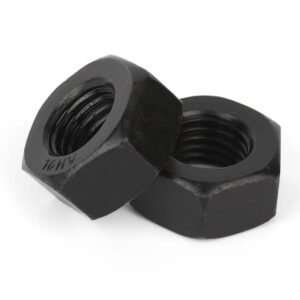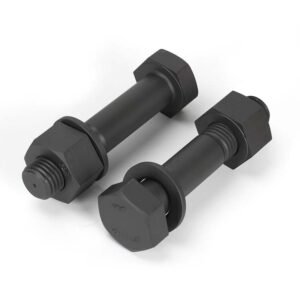Zinc Plating for Carbon Steel Fasteners
Zinc Plating: The Essential Surface Treatment for Carbon Steel Fasteners
Zinc plating is one of the most widely used surface treatment methods in the fastener industry, offering excellent corrosion resistance and improved aesthetic appearance. When applied to carbon steel fasteners, zinc plating enhances durability without compromising structural integrity.
Overview of Zinc Plating
Definition
Zinc plating, also known as electro-galvanization, is the process of applying a thin layer of zinc to the surface of a metal—most commonly carbon steel—to protect against corrosion. This is typically achieved through electroplating, where zinc ions are deposited onto the fastener in a controlled electrolytic solution.
Technical Background
Zinc plating has been in use for over a century, with significant advancements in plating composition, thickness control, and post-treatment processes. In the fastener industry, it’s a go-to method for balancing cost efficiency with satisfactory corrosion protection. It continues to evolve with demands for better environmental compliance and improved performance.
Common Uses and Applications
Suitable Fastener Types
Zinc plating is widely applied to:
- Bolts
- Screws
- Nuts
- Washers
- Threaded rods
- Self-tapping screws
- Machine screws
Application Industries
| Industry | Usage Example |
|---|---|
| Automotive | Engine components, body panels |
| Construction | Structural connections, framing |
| Electrical | Junction boxes, cable fasteners |
| Machinery | Equipment assembly |
| Aerospace | Non-critical structural parts |
| Consumer Goods | Outdoor furniture, appliances |
Key Performance Features of Zinc Plating
| Feature | Description |
|---|---|
| Corrosion Resistance | Moderate protection; salt spray resistance up to 96-200 hours with passivation. |
| Aesthetic Quality | Can appear bright or matte; available in clear, yellow, black, or olive drab finishes. |
| Surface Hardness | Slightly increased depending on post-treatment; not a significant wear-resistant finish. |
| Electrical Property | Generally conductive; not suitable when high insulation is required. |
Zinc Plating Process Workflow
Pre-Treatment Steps
- Degreasing: Removes surface oil and grease.
- Pickling: Removes oxides or rust.
- Rinsing: Eliminates chemical residues.
Plating Stage
- Electroplating: Zinc is applied via passing a current through a zinc-salt solution.
- Duration and current density affect thickness (typically 5–25 microns).
Post-Treatment Process
- Passivation: Adds chromate layer for further corrosion resistance.
- Drying: Removes moisture to prevent white rust.
- Sealing: Optional step to further improve endurance.
Pros and Cons of Zinc Plating on Fasteners
Advantages
- Cost-effective compared to other coatings such as hot-dip galvanizing.
- Smooth finish enhances part movement, especially important for threaded fasteners.
- Environmentally improved through trivalent chromate systems.
- Easy to inspect for coverage and uniformity.
Disadvantages
- Lower corrosion resistance compared to hot-dip galvanizing or zinc-nickel plating.
- Risk of hydrogen embrittlement if not properly baked after plating.
- Not suitable for marine or highly corrosive environments without further treatment.
Zinc Plating vs. Other Fastener Coatings
| Treatment | Salt Spray Resistance | Cost | Common Use |
|---|---|---|---|
| Zinc Plating | 96–200 hrs | Low | General-purpose fasteners |
| Hot-dip Galvanized | 600+ hrs | Medium | Outdoor/structural components |
| Zinc-Nickel | 720–1000 hrs | High | Automotive, aerospace |
| Phosphate Coating | 24–72 hrs | Low | Assembly, lubrication |
Compliance, Safety & Environmental Aspects
Modern zinc plating often uses trivalent chromium passivation to replace hazardous hexavalent compounds. This ensures compliance with international standards like:
- RoHS (Restriction of Hazardous Substances)
- REACH
- ISO 2081:2018 for electroplated zinc coatings
Additionally, manufacturers must ensure safe work environments due to the use of acidic solutions and electrochemical technology.
Economic Value of Zinc Plating
Zinc plating is one of the most economically feasible choices for carbon steel fasteners. Initial setup costs are lower than alternative coatings. With proper thickness, passivation, and maintenance, zinc-plated fasteners offer value for applications where extreme corrosion resistance is not critical.
Conclusion
At Flybear Fastener, we understand that surface treatment plays a critical role in fastener performance and lifecycle. For carbon steel components, zinc plating offers a solid balance of affordability, functional protection, and aesthetic enhancement. Whether you’re looking for standard bolts or customized components, our wide range of fastener products caters to diverse industry demands.
We proudly offer tailored industry solutions that meet your project’s surface treatment and performance requirements. Feel free to contact us for reliable recommendations and competitive quotes that align with your operational needs.








